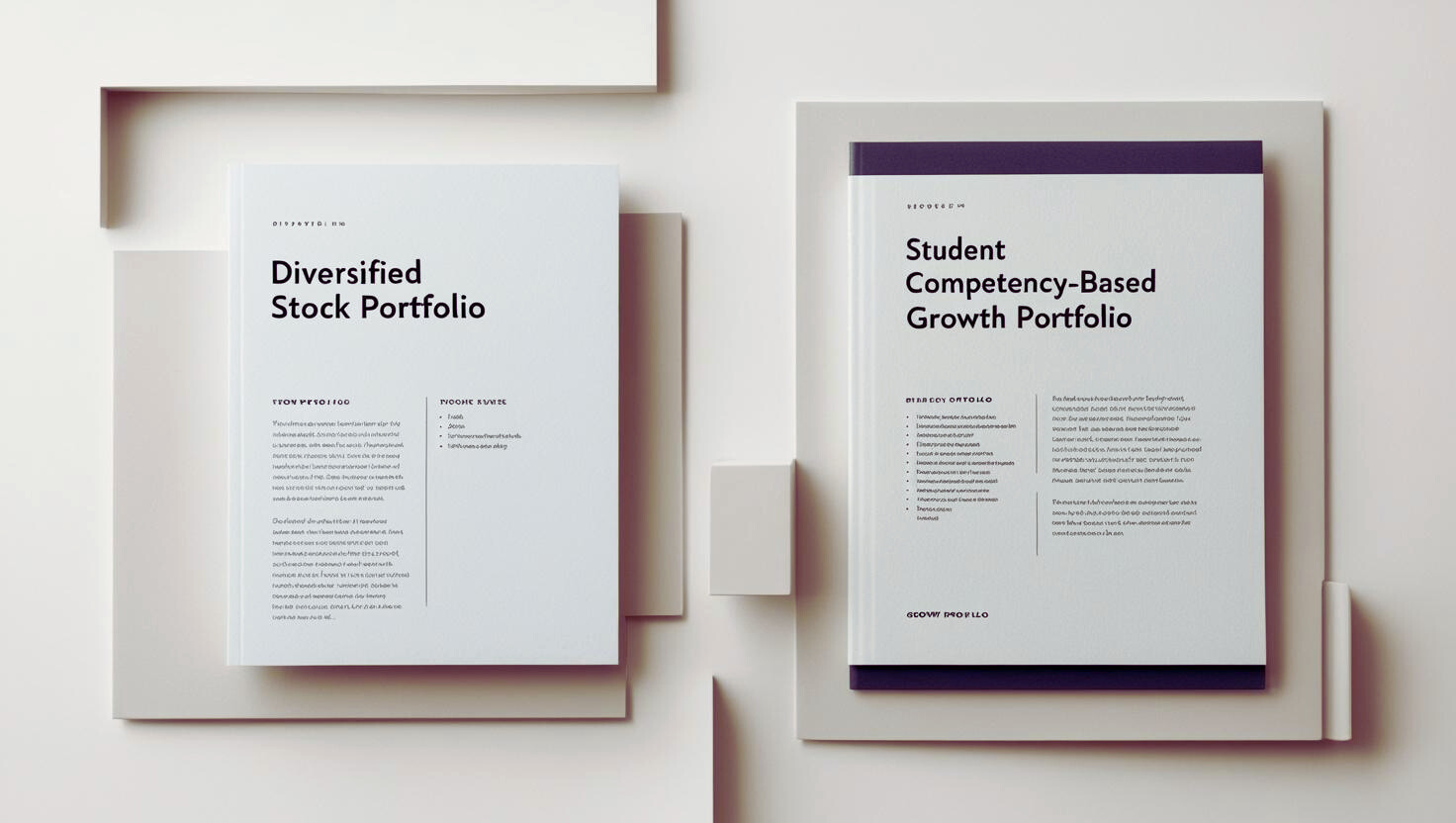The Student Growth Portfolio
Written by Tim Cook
The Student Growth Portfolio: Applying Investment Principles to Holistic Educational Development
Imagine a third-grade classroom where students aren't just turning in assignments but instead they're building portfolios that showcase their growth across multiple dimensions. In one corner, Aiden reviews his reading fluency recordings from September alongside his most recent performance, noting the improvement in his expression. Nearby, Maya works on a personalized learning pathway, documenting her journey from from learning about hieroglyphics and CIA codes to producing her own secret language. This aren’t just assessments, they are investments in future transferable competencies that these students can apply in the future.
Traditional education often resembles short-term trading: chasing quarterly test scores and annual proficiency rates while losing sight of the comprehensive development that truly prepares children for fulfilling lives. Just as financial advisors warn against measuring success by single-quarter returns, educators must resist reducing student growth to standardized test percentiles alone.
This article proposes a paradigm shift: applying investment principles to student development through a comprehensive growth portfolio approach that captures the full spectrum of a child's evolving capabilities, dispositions, and potential.
A diversified stock portfolio on the left and a student competency-based growth portfolio on the right
Expanding Our Definition of Educational Returns
When we talk about "returns" in education, the conversation typically revolves around test scores, college admission rates, and future earning potential. These metrics, while important, represent only a fraction of what constitutes meaningful human development.
Research from the Aspen Institute's National Commission on Social, Emotional, and Academic Development has demonstrated that integrating social-emotional learning with academic development improves both academic and life outcomes (Aspen Institute, 2019). Similarly, the science of learning and development shows that cognitive, social, and emotional processes are deeply intertwined in the brain's architecture (Cantor et al., 2019).
A comprehensive student growth portfolio expands our definition of "returns" to include:
Emotional resilience and well-being : The capacity to navigate challenges, regulate emotions, and maintain positive mental health
Community engagement : The ability to contribute meaningfully to one's community and build positive relationships
Creative expression : The development of unique voices and innovative problem-solving approaches
Self-knowledge : The metacognitive understanding of one's learning processes and personal identity
Like a diversified investment portfolio, a student's developmental journey should include various "asset classes"—academic foundations, social-emotional competencies, physical development, creative expression, cultural knowledge, and metacognitive skills. Each domain contributes uniquely to a child's overall growth trajectory and future adaptability.
Investment Principles in Educational Practice
Financial advisors emphasize the power of compound interest over time. Similarly, educational development compounds when foundational skills and dispositions are given time to mature and interconnect.
In my third-grade classroom, we implemented a research process that allowed students visual represent their knowledge when working with informational texts. One student read significantly below grade level and initially struggled to extract key information from grade-level texts. Rather than limiting her research opportunities or fully resorting to audio modification, I documented her exceptional visual and spatial thinking abilities to show how she could communicate concepts through charts, visuals, and design choices. By teaching her to use text features like headings, captions, and bolded terms as entry points into complex texts, we built a bridge between her reading challenges and communication strengths. By mid-year, her ability to research independently had improved dramatically, not by focusing exclusively on decoding and fluency drills, but by leveraging her visual communication talents. Her final infographic and presentation on protecting wildlife demonstrated sophisticated content understanding on par with her grade-level peers, showcasing how alternative pathways to accessing and presenting information can circumvent reading barriers.
Research from the National Reading Panel on the science of reading supports this approach, showing that reading skills develop through interconnected processes that strengthen each other over time. The student growth portfolio captures these developmental trajectories, celebrating progress during plateaus and documenting the compounding effect of consistent effort.
Portfolio Diversification
Investment advisors recommend diversification to manage risk and maximize returns. Similarly, a well-diversified student growth portfolio acknowledges multiple intelligences and varied pathways to success. This approach aligns with research on multiple intelligences and learning styles, suggesting that diverse assessment methods more accurately capture student capabilities (Gardner, 2011). A diversified student portfolio legitimizes various forms of intelligence and creates multiple pathways for students to experience success.
Calculated risk-taking is essential for growth, but must be balanced with appropriate safeguards. Similarly, educational development requires thoughtful risk-taking within supportive environments. Research on growth mindset confirms that embracing challenges and learning from setbacks contributes significantly to long-term development (Dweck, 2016). The portfolio approach reframes "failure" as an essential component of the learning process and an area where the most growth can be had.
Implementing the Student Growth Portfolio Approach
Transforming educational assessment into a growth portfolio model requires systematic shifts in practice:
Establish baseline assessments across multiple domains at the beginning of each year, including academic, social-emotional, creative, and physical dimensions.
Involve students in portfolio curation by teaching them to select evidence that demonstrates growth rather than just achievement. In the classroom this means that students can articulate why a particular writing sample showed improvement over previous work.
Create reflection routines where students regularly analyze their progress, set goals, and identify needed supports. These metacognitive practices build self-awareness and agency.
Implement digital portfolio platforms like Canva or Google Sites that allow for multimedia documentation of growth. This technology enables students to capture performances, presentations, and process work that paper portfolios cannot accommodate.
Schedule portfolio conferences with students, parents, and teachers that focus on growth trajectories rather than achievement levels alone. These conversations shift the narrative from "How is my child doing compared to others?" to "How is my child growing across multiple dimensions?"
From Standardized Benchmarks to Growth Trajectories
The student growth portfolio approach represents a fundamental shift in how we conceptualize educational success, moving from standardized benchmarks to personalized growth trajectories that honor the complexity of human development.
When we apply investment principles to education, we recognize that the most valuable returns often appear in unexpected places and unfold over longer time frames than our assessment systems typically measure. We acknowledge that diversification builds resilience, that compound growth requires patience, and that calculated risk-taking drives innovation.
Most importantly, we empower students to become active investors in their own development, conscious of their strengths, mindful of growth opportunities, and confident in their capacity to build a portfolio of competencies that will serve them throughout life.
As educators, our role shifts from evaluators of standardized performance to portfolio advisors, helping each student build a diversified collection of capabilities that will yield returns long after they leave our classrooms. In doing so, we prepare them not just for tests and college admissions, but for the complex, ever-changing world they will help create.
References
Aspen Institute. (2019). From a Nation at Risk to a Nation at Hope: Recommendations to Transform Education. Aspen Institute.
Cantor, P., et al. (2019). The Science of Learning and Development: A Comprehensive Framework. Harvard Education Press.
Gardner, H. (2011). Frames of Mind: The Theory of Multiple Intelligences. Basic Books.
Dweck, C. (2006). Mindset: The New Psychology of Success. Random House.
Disclaimer: This article’s research was conducted with the assistance of EdConnect, an optimized Intelligence Assistant for educational research and integration. © 2025 The Connected Classroom. All rights reserved.

